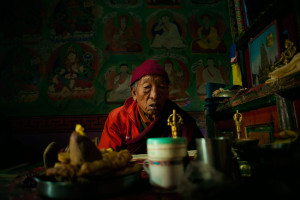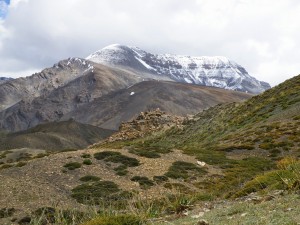1. Tabo
Tabo village situated in Spiti Valley is home to the ancient Tabo Monastery. The monastery was founded in 996 CE, by the Tibetan Buddhist, Rinchen Zangpo, the king of the western Himalayan Kingdom of Guge.
A treat for the cultural tourists, Tabo is noted for being the oldest continuously operating Buddhist enclave in both India and the Himalayas. A large number of frescoes displayed on its walls depict tales from the Buddhist pantheon. There are many priceless collections of Thankas (scroll paintings), manuscripts, well-preserved statues, and extensive murals, which cover almost every wall. It is here that the 14th Dalai Lama held the Kalachakra ceremonies in 1983 and 1996. The Archaeological Survey of India protects the Gompa as a national historic treasure.
2. Dhankar
The village is home to the fort Monastery of Dhankar, at an elevation of 12,774 ft. The complex is built on a 1000-foot high spur overlooking the confluence of the Spiti and Pin Rivers – one of the world’s most spectacular settings for a Gompa. Dhang or dang means cliff, and kar or khar means fort. Hence Dhankar means fort on a cliff.
The surroundings of Dhankar consist of a desert lunar landscape, unlike any other in the world. Dhankar was the traditional capital of the Spiti Valley Kingdom during the 17th century and has some features dating back to the 12th century. It was the seat of the early rulers of Spiti, the Nonos. It is a bulwark of ancient Buddhist architecture and sheltered the indigenous population through out history.
3. Komic
Komic in Spiti Valley is the highest inhabited village in Asia at a height of 15,000 ft + and is also home to the Tangyud Monastery. The village has only 12 houses and a population of about 150. The village offers breathtaking views of vibrant Spiti scenery, sure to leave you at an utter lack of words.
The Tangyud Monastery is built like a fortified castle on the edge of a deep canyon, with massive slanted mud walls and battlements with vertical red ochre and white vertical stripes. It is the highest monastery in the world, housed on the edge of a deep canyon and overlooking the town of Kaza. It is situated on the periphery of the Kibber Wildlife Sanctury, home to animals such as the rare snow leopards, blue sheep, ibex, yaks and several species of birds.
4. Ki
The Ki Monastery, built on top of a hill overlooking the Spiti River, is a fortress established around 1000 CE. One of the highlights of Spiti Valley, it is a religious learning center for Lamas, and houses around 150 monks on an average. It is a historical sight, which has survived multiple attacks and raids by civilizations of antiquity.
There are three floors that house several ancient Tibetan artifacts. One room, called the Tangyur is richly painted with murals and the ground floor has a beautifully decorated Assembly Hall and cells for many monks.
5. Kungri
Kungri Monastery is a Buddhist monastery of the Nyingma sect of Tibetan Buddhism in Pin Valley a part of Spiti.
Kungri is Spiti’s second oldest monastery, built around 1330. The Gompa consists of three detached rectangular blocks facing east. It is noted for its sword dance by the Buzhens of Mud village on the right bank of the Pin River. Within the Gompa, attractions include silk paintings of various Buddhist deities on the inner walls, huge statues and over 300 volumes of the sacred Tibetan texts, Kenjur and Tenjur preserved carefully in white muslin.
6. Lhalung
Lhalung Monastery (also known as the Sarkhang or Golden Temple), was one of the earliest monasteries founded in Spiti by the great Tibetan Buddhist lotswa, Rinchen Zangpo, the king of western Himalayan Kingdom of Guge during the late 10th century CE.
The name Lhalun literally means ‘land of the gods’and it is said that the Lhalung Devta is head of all the Devtas of the valley and emerges from the Tangmar mountain beyond the village. This mountain is said to change colour depending on the moods of the devtas or deities; red showing anger, yellow, happiness, etc.
At some places remains of an ancient wall encircling all the monastery buildings may be found. Like Tabo, the local people designed it as a choshorsite, a place for learning and debate as opposed to a simple village monastery or a chapel for worship. There is also a sacred tree here, which is as old as the earliest monastery.
7. Kibber
Kibber is a village high in the Spiti Valley in the Himalayas at an elevation of 14,200 ft. It contains a monastery and the Kibber Wildlife Sanctuary. Kibber lies in a narrow valley on the summit of a limestone rock. Agriculture forms the backbone of the local economy and lush green fields are abundant.
The village has around 80 houses, unique, as they are made of stone instead of mud or adobe brick used extensively elsewhere in the Spiti valley. It is an enriching cultural experience that shows all aspects of local life.
Kibber is situated around prime snow leopard territory and is rich with high altitude wildlife and serves as the main base for the exclusive and sought after Spiti United Snow Leopard Expeditions.
8. Tashigang
Tashigang is one of our most famous campsites in Spiti Valley. A lush green meadow amidst unbelievable views of Mt Kanamo (20,000 ft) and the CC Kane peaks (20,000 ft +), it is known to be H.H Dalai Lamas favorite outdoor excursion since his youth. With several treks, strolls and walks around, it is an experience of nature that simply cannot be missed. There is a short trail to a meditation cave that is known to be more than 5,000 years old. An overnight camping experience in this beautiful location is surely something that will be cherished forever. A 4 hr trek from Tashingang takes you atop the Pien peak at an elevation of 16,000 ft and provides mesmerizing views of the entire valley of Spiti.
9. Kaza
The town of Kaza is the headquarters of Lahaul and Spiti. Kaza is equipped with modern facilities like wifi internet, hosptials and also has a selection of restaurants and cafes. It’s a central point where our travelers can buy all necessities for their stay in Spiti. High mountain ridges on all sides overlook Kaza and it is also hosts several festivals of the region. The Navoydhya mountain near Kaza has a special place in the local culture and traditions.
10. Chandratal Lake
Chandra Taal (meaning the Lake of the Moon), is situated at an altitude of about 14,100 ft in the Himalayas. Mountains of scree overlook the lake on one side, and a magnificent cirque presents a view on the other. The name of the lake originates from its crescent shape. Chandra Taal is a popular destination for trekkers and campers. The lake is accessible on foot from Batal as well as from Kunzum Pass. Vast meadows on the banks of the lake are the camping sites. During springtime, these meadows are carpeted with hundreds of kinds of wildflowers. The picturesque lake is one of two high-altitude wetlands of India, which have been designated as Ramsar sites.
11. Lohsar
The picturesque hamlet of Losar is the entrance town of Spiti Valley while coming from the Manali Road. It is a popular town to halt amongst bikers and has it’s own offering of restaurants and cafes.
12. Nako
Nako is a tiny village area in Spiti Valley. The area is known for its lake, Nako Lake that forms part of the border of the village. Nako Monastery is located in the village as well as several other Buddhist temples. It is a little visited but a rewarding destination none the less.
13. Kalpa
Kalpa is a town with a history of ancient temples. The Sutlej River below hurtles through deep gorges, and Chilogza forests border the winding mountain road. The view from Kalpa is beautiful with an observer getting the feeling that he is sitting in the lap of the mountains with the entire range of peaks being visible. Also visible from this place is a majestic view of the sacred Shivling rock on the Kailash Mountain that changes its color at different points in the day. It is also famous for it’s apple orchards and is one of the most beautiful villages in Kinnaur Valley.
14. Gue
The Gue village in Spiti Valley is famous for housing the remarkably well-preserved, 500 year old natural mummy of monk Sangha Tenzin. It was found in 1975 after an earthquake and is now at display in a small tomb. Whoever thought mummies exist only in Egypt, please think again and check out this marvel in our own Spiti.
15. Rangrik
Rangrik in Spiti is a beautiful small town by the banks of river Spiti. It is nice place to camp out by the river and spend the evening at leisure around a bonfire and grilling foods on a BBQ.
16. Pin Valley National Park
Steeped in historical and present day Buddhist Tibetan culture, the area has many Tibetan Buddhist influences, evident architecturally in monasteries and stupas, and in the daily living of its residents and lamas.
The park is located in the desert habitat of the Spiti Valley, within the Cold Desert Biosphere Reserve, in the Himalayas region. Spreading south of Dhankar Gompanear the Tibetan border, the park marks the border between the formerly separate districts of Lahaul and Spiti. The elevation of the park ranges from about 11,500 ft near Ka Dogri to more than 20,000 ft at its highest point. It also has several villages within it, which provide for great homestays and cultural experiences, mud being the most famous. Because of the park’s high altitude and extreme temperatures, the vegetation density is sparse, consisting mostly of alpine trees and groves of Himalayan Cedar. In summer, rare birds such as the Himalayan snowcock, chukar partridge, snow partridge and snowfinch flourish in the park. With its snow laden unexplored higher reaches and slopes, the Park forms a natural habitat for a number of endangered animals including the snow leopard and Siberian ibex.
17. Sopona Lake
The little known and unexplored lake of Sopona in Spiti is set amidst snow-clad mountains and is an example of untouched nature at it’s best. It is accessible via a very scenic trek through the valley and indeed a paradise for the hermit travellers.
18. Hikkim
The high altitude village of Hikkim houses the highest post office in the world. Post a letter home to your loved ones to be treasured forever.
19. Langza
Langza is a famous fossil park in the region of Spiti. Fossils found here are millons of years old since the time when there were no Himalayas and the region was just an ocean – the Tetis Sea. These remnants of ancient earth are absolutely priceless and are sought after by historians, archaeologists and collectors alike.







